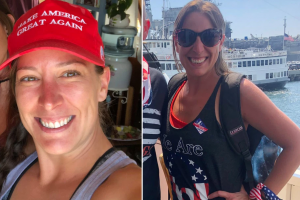
On January 6, 2021 an out-of-control group of (mostly, but not all) supporters of President Trump “stormed the Capitol” building in Washington, D.C. And though Democrats and the media falsely claimed that a Capitol police officer was mercilessly bludgeoned to death, only one person died that day on the Capitol grounds as a result of a homicide — 14-year Air Force veteran, Ashli Babbitt. There has been virtually no outrage over the shooting death of this 5’2″ 110 pound, unarmed woman by a U.S. Capitol Police (USCP) lieutenant.
For the last six months, the name of the USCP officer who shot Babbitt has been unknown except to Congressional leadership, law enforcement and some in the media. New information has surfaced within the last few weeks regarding the (public) identity of her killer which still remains formally withheld by the USCP.
Paul Sperry of Real Clear Investigations has recently publicized the name of the officer who fired the fatal shot. This article will say who he likely, not confirmed, is but mostly focus on what transpired at the scene in the seconds leading up to her unjust death along with inconsistencies in the shooter’s story.
Ashli Babbitt was the victim of a personally fatal decision to raid the Capitol, extremely poor judgement on the part of the shooter, poor communication within the USCP and very unlucky timing.
Some of the many questions that need answers: Was the lethal action legally justified or was it pure negligence? Did the officer who shot Babbitt follow training protocols or did he act improperly and impulsively?
One fact will be made very clear. Though some USCP officers were clearly wired for inter-organization communication, an astonishing lack of coordination between the shooter and other officers within just a few feet of Babbitt contributed enormously to her death.
And finally, one major question cannot be ignored. Given our highly politicized and now “racialized” culture that permeates every aspect of society since the murder of George Floyd, was there a racial component to prosecutors’ decision not to criminally charge the officer?
One “Homicide” Invented, One True Homicide Ignored
Five people died related to the Washington D.C. protests and Capitol riots within 48 hours of each other. Three of the individuals are relatively unknown; two died from natural causes (cardiac issues) and one from an accidental drug overdose. Two of the deaths were more widely reported – one in particular.
Capitol Police Officer Brian Sicknick was at the Capitol during the riots and died one day later on January 7, 2021. Officer Sicknick was heavily politicized in death. There is likely no better example of the media driving a political narrative than the “report” by the New York Times that said Officer Sicknick died from head trauma shortly after having his head savagely bludgeoned with a fire extinguisher by pro-Trump fanatics.
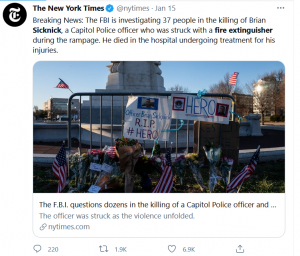
On January 8, 2021, the Times ran an article about the death of Officer Sicknick with the headline, “Capitol Police Officer Dies From Injuries in Pro-Trump Rampage.” Of course with the Times being the “newspaper of record”, virtually all other media outlets quickly ran with the report.
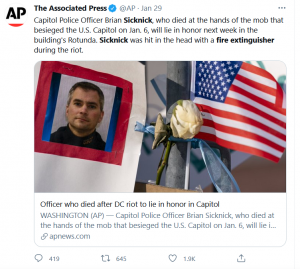
Even weeks later, the Associated Press tweeted, “…Sicknick, who died at the hands of the mob that besieged the U.S. Capitol … was hit in the head with a fire extinguisher during the riot.”
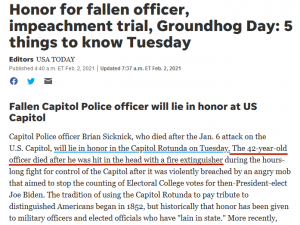
Not to be outdone, on February 2 just a week before the impeachment trial of former President Donald Trump, a USA Today article said the “officer died after he was hit in the head with a fire extinguisher…”
The Times article was completely false. It was known immediately following Sicknick’s death that there was no evidence of head trauma. But the Times conveniently waited until Trump’s impeachment trial ended on February 13 before making the correction from its incendiary article from January. (Trial dates were Feb. 9 – 13.)
This erroneous report about Officer Sicknick’s unfortunate death became a rallying cry for the media and Washington Democrats. In fact, it became the cornerstone of the Democrat prosecutors’ narrative at Trump’s impeachment trial. House Speaker Nancy Pelosi said Sicknick was killed by “insurrectionists” and was “a martyr for democracy.”
The Democrats falsely stated in their pretrial impeachment memo, “The insurrectionists killed a Capitol Police officer by striking him in the head with a fire extinguisher.” (P. 31 of 80)
Officer Sicknick’s death was the key support for the “insurrection” narrative of five people dying as a result of the Capitol riots. Five did die but only Ashli Babbitt’s death was ruled a homicide.
Throughout history just four police officers have lain in honor in the Capitol Rotunda. Officer Sicknick is the only one of the four not to have died in the line of duty.
On April 19, nearly four and one half months after the January 6 riot, Washington D.C. Medical Examiner Francisco Diaz finally and officially reported that USCP Officer Brian Sicknick had died of “natural causes.” He suffered two strokes that were caused by a blood clot at the base of his brain stem.
The report was so unequivocal that even The Washington Post had to state the truth about Sicknick’s death. The Post said, “the autopsy found no evidence the 42-year-old officer suffered an allergic reaction to chemical irritants, which Diaz said would have caused Sicknick’s throat to quickly seize. Diaz also said there was no evidence of internal or external injuries.”
According to the Medical Examiner, the only homicide that occurred on January 6 was the shooting death of Ashli Babbitt by a Capitol police officer. [Three other protesters died that day: Kevin Greeson, 55, and Benjamin Phillips, 50, died “of natural causes from cardiovascular disease.” Roseanne Boyland, 34, apparently died accidentally from “acute amphetamine intoxication” according to the medical examiner.]
It took four months to find out the official causes of death for Officer Sicknick and the others but now six months after the event, and though it still has not been officially released, the name of the Capitol police officer who killed Babbitt is finally known.
No Criminal Charges Filed Against Shooter
The Justice Department said on April 14 that the USCP lieutenant who shot and killed Ashli Babbitt in the January 6 Capitol riots won’t face any criminal charges in the homicide of the Air Force veteran.
Federal prosecutors said they examined video footage and conducted extensive interviews with the officer and other witnesses. They also said they studied the autopsy results in reaching their final conclusion that the deadly shooting did not warrant any criminal charges.
The DOJ’s statement said, “The investigation revealed no evidence to establish that, at the time the officer fired a single shot at Ms. Babbitt, the officer did not reasonably believe that it was necessary to do so in self-defense or in defense of members of Congress and others evacuating the House chamber.”
The lieutenant’s lawyer, Mark Schamel, said his client only fired after Babbitt crawled through a doorway where the glass had been broken, after police had ordered her and other rioters not to breach the locked doors and enter the hallway.
However, as we shall see, the lieutenant purportedly had no idea other police were within 20′ or so of him when he fired the shot nor could he have known of any instructions given to the crowd by other police officers.
He reportedly told those investigating the shooting that he heard reports that pipe bombs had been found on rioters elsewhere in the Capitol. He said he considered his life in danger, though it is unknown why he made the determination to make a deadly stand in this particular doorway and not retreat or get more police support.
The lieutenant said he had no idea who, if any among the protesters, were armed. He also claimed he had no idea there were other officers extremely close to his line of fire on the opposite side of the doorway. He said in his statement he couldn’t see the other officers, only a hallway full of people.
The lieutenant added that seeing Babbitt’s backpack was a factor in his decision to shoot her. Based on line-of-site angles in that area, as we shall see it is highly questionable that he could have actually seen the smallish backpack before he committed to take the shot.
What was in Babbitt’s backpack? A pipe bomb, firearm, retractable baton or bear spray? No, she was carrying a wool sweater and a scarf.
* * *
Even though D.C.’s Metropolitan Police Department is required to publicize the name of any officer involved in a fatal shooting within a few days, the U.S. Capitol Police are not. They are controlled by Congress.
Though investigators had previously mentioned the officer was a lieutenant, they declined to mention his name until the criminal probe is officially closed. Mr. Schamel said his client “exercised professionalism and fantastic restraint.” Apparently had he not exhibited “fantastic restraint” he would have shot more unarmed people in the doorway.
The USCP promised, in a statement back in February, that it would provide additional information about the officer involved “once the investigation is complete.” The DOJ completed its investigation in April but now three months later no name has been released.
This lack of official information has led to considerable speculation as to the identity of the shooter whose name likely won’t be widely publicized and confirmed until it is revealed in court due to a lawsuit against the USCP by Babbitt’s family.
The Babbitt family is suing “‘for documents that identify the officer who shot Babbitt … as well as notes and summaries of what the officer said regarding the shooting and the reasons he discharged his weapon.’” A hearing is scheduled on September 3rd.
The family’s attorney, Terry Roberts, said his investigation has positively identified the shooter after extensive research but with no assistance from USCP.
The report by Sperry at Real Clear Investigations says that the USCP lieutenant’s name was inadvertently cited in a House hearing back in February. Lieutenant Michael L. Byrd was mentioned by the acting House sergeant at arms on February 25. (Lieutenant Byrd’s name is clearly audible around 39:24.) Both C-SPAN and CNN censored his name in their transcripts of the hearing.
According to Sperry, USCP Communications Director Eva Malecki has neither confirmed nor denied that Byrd is the shooter. Interestingly, following the shooting, Lt. Byrd’s internet footprint was erased including photos and any information on social media.
Lt. Byrd committed an egregious breach of officer protocol in February 2019 when he left his service weapon, a .40 caliber Glock 22, unattended in a restroom. Fortunately, it was later discovered without incident. Spokesperson Malecki said at the time that appropriate disciplinary action had been taken against Lt. Byrd.
A freelance journalist, Taylor Hansen, was outside the Speaker’s Lobby doorway where Babbitt was shot and has reportedly positively identified Lt. Byrd as the shooter.
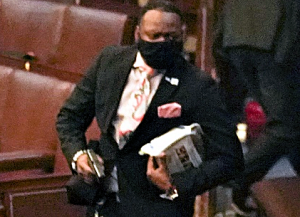
As was originally alleged in the Gateway Pundit, the officer shown in these photos, Lt. Michael Byrd, is likely the same man who shot Babbitt apparently without warning.
As seen in photo #1, Lt. Michael Byrd “is the commander of the House Chamber Section of the Capitol Police.”
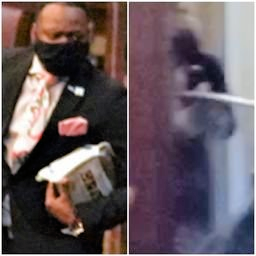
Byrd’s appearance here closely matches that of the shooter as seen in photos #2 and #3. He’s the well-dressed African-American man first seen in the House Chamber. His high forehead, pink pocket handkerchief, beaded bracelet and lapel pin matches the appearance of the man firing his gun at Babbitt.
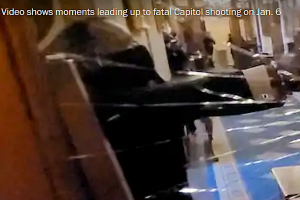
Look closely at photo #4 (the close-up can be seen in photo #1) likely taken in the House Chamber at the point of maximum siege by the rioters as USCP officers can be seen behind a makeshift barricade at a rear doorway with guns drawn.
Notice the position of Lt. Byrd in the background with the pink pocket square
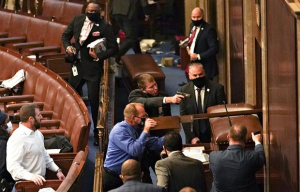
holding what appears to be a large, thick book. His experience and position make it all the more astounding that he is violating some of the most basic gun safety rules. He is both pointing his weapon at the backs of his fellow officers and has his finger on the trigger, not on the slide further jeopardizing the officers’ safety. This is astonishing for a trained professional.
In photo #5 Lt. Byrd can be seen at the podium purportedly giving instructions to House members on how to exit the Chamber safely.
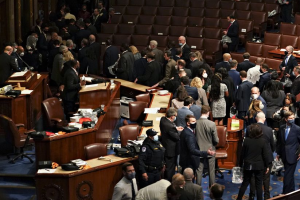
In these few photos in which the apparent Lt. Byrd appears, it is likely that his movements went in this general sequence: the podium in the House Chamber as he instructed members to leave through the Speaker’s Lobby — to a rear (north) doorway that was barricaded and strongly defended — to the southeast doorway to the Speaker’s Lobby where the shooting occurred.
Shooting Timeline and Narrative of Events
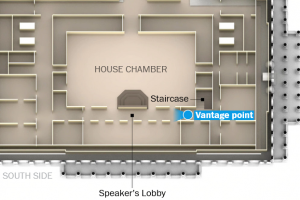
The screenshots below are from two separate video vantage points but of the same place at the same time. Each is important in that it provides a different but valuable view or specific time not found in the other. All take place at the southeast entrance doorway to the Speaker’s Lobby in the U.S. Capitol Building and nearby stairway as seen in the graphic that was published in The Washington Post.
A number of the screenshots below are from a video taken by John Sullivan, a.k.a. Jayden X and published by The Washington Post. The other screenshots are taken from an unknown videographer but available on YouTube.
Sullivan is an interesting character and an unlikely co-participant with Trump supporters in the Capitol riot. The African-American founder of Insurgence USA and a Black Lives Matter supporter, Sullivan was just a few feet from both the shooter and Babbitt.
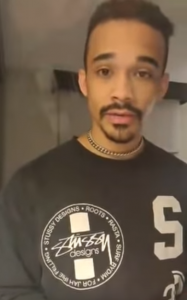
Though he was urging on pro-Trump protesters at the Capitol in January, just a few months before he can be seen calling for Trump’s removal from office at a protest he organized that intentionally blocked motorists.
Sullivan was arrested after vehicles were damaged and even shots were fired toward motorists attempting to navigate around the protesters.
During the riot and breach of the Capitol, Sullivan claimed to be there as a video journalist. He said he knew that the Capitol was going to be stormed at least 4 weeks before the event.
A week after the January 6th riot and death of Ashli Babbitt, Rolling Stone magazine published an article about John Sullivan, a.k.a. Jayden X. He claimed he had to appear to be a Trump sympathizer to protect himself, yet according to Rolling Stone, he can be heard yelling, “‘It’s a motherfucking revolution, let’s take this shit.”
Sullivan says he saw the Capitol police officer’s arm and gun suddenly appear from a side doorway. He said, “The guy who was pointing a gun at her was (sic) leaning with an intent to shoot; he was not playing. There’s difference between holding a gun up and warning somebody versus, like, really leaning into it.”
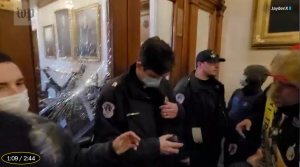
These events appear to have occurred subsequent to Lt. Byrd directing the House members to leave the Chamber through the Speaker’s Lobby and exit out the southwest or opposite side.
In photo #7, armed, uniformed officers along with a plainclothes officer/supervisor (?) guard the Speaker’s Lobby doorway less than 2 minutes before the fatal shooting.
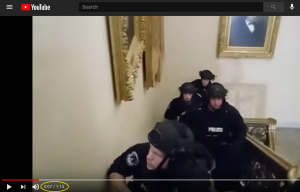
Photo #8 shows a heavily armed tactical team making its way up the stairway to relieve the uniformed officers in front of the doorway.
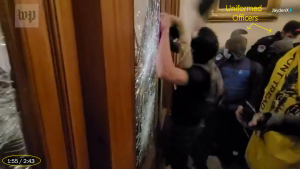
In photo #9 we see the view from Sullivan’s vantage point what shows the uniformed officers along the wall making their way toward the stairway. This is the scene within approximately 2 seconds from when Sullivan can be heard on his video yelling, “There’s a gun, there’s a gun!”. It is only 3 seconds from when Sullivan swings his camera around to capture the shooter’s gun which is visible, pointed and ready to fire.
Here’s a (blurry) screenshot of Sullivan first capturing the gun in photo #10 and a side-by-side view of the gunman’s hand just a second or so later in a clearer shot. Notice the beaded bracelet seen here that is also visible on Lt. Byrd’s right wrist in photo #1. Also evident in photo #10 is that he already has his finger on the trigger, not on the slide.
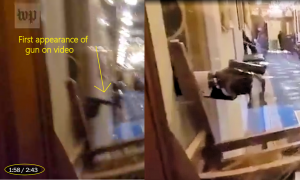
In order to believe Lt. Byrd’s story that he saw no officers on the other side of the doorway, he would have had to show up at the scene and draw his gun ready to fire almost immediately at the exact time Sullivan yells, “gun” not to have seen his fellow officers in the line of fire.
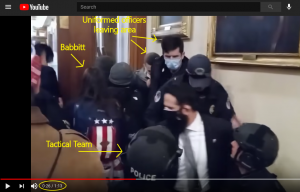
Photo #11 from the YouTube video at 0:26 is the scene at the top of the stairway within 2 seconds of when Sullivan yells, “Gun!”. It captures the same scene as Sullivan’s video at 1:55 in photo #9, only from a different angle. Amazingly, six armed USCP officers are seen all within maybe 20′ feet of where the shooter is pointing his weapon.
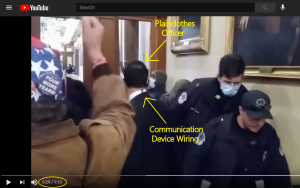
Clearly the lieutenant’s (shooter’s) vision is obscured from his vantage point but unless he had just gotten to that doorway and raised his gun it barely seems credible that he could not see those other officers. (Another possibility is that he did see them —leave— and perhaps fearfully thought he would be left alone to deal with the mob.)
Within two seconds from John Sullivan yelling “gun,” the plainclothes officer/supervisor has turned back around and moved closer to the doorway as we seen in photo #12. It is unclear whether he was making sure his officers left the floor safely or actually heard Sullivan’s yell. (Sullivan’s shout is not audible on the YouTube video.)
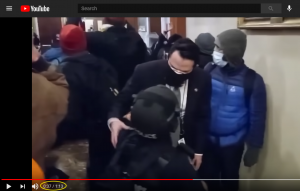
This is now 13 seconds before Ashli Babbitt will be shot. It means the gun is pointed and ready to fire before the 5’2″ Babbitt can even be seen or has begun her ascent to climb through the sidelight opening. Additionally, wiring for a communication device is visible on the officer/supervisor but apparently the arrival of a tactical team at the scene was never communicated to the shooter.
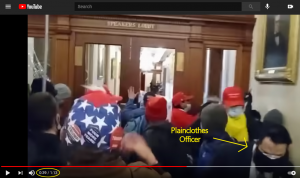
The tactical team leader has stopped at the top of the stairway to speak with the plainclothes officer/supervisor in photo #13. Whatever was discussed between the two was very unfortunate for Ashli Babbitt. It prevented the tactical team from securing the site and the shooter from seeing their presence. This is now just 5 seconds before Babbitt is shot.
The camera view has shifted slightly in photo #14 but the officer/supervisor remains visible as he is likely still talking to the tactical team member at the top of the stairs since the team has yet to fully ascend the staircase to guard the doorway. In the background, Ashli Babbitt is about to climb into the opening in the sidelight on the right. She will be fatally shot in 3 seconds.
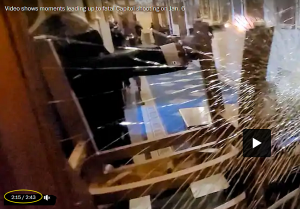
Photos #15 and #16 show the exact moment Babbitt is shot. The screenshot from the Sullivan video (#15) captures Lt. Byrd’s firing his gun and the YouTube video shows Babbitt at the top of the sidelight. Notice (more clearly discernible in the video) the aggressive forward leaning move into the shot that the lieutenant makes. This was not accidental or inadvertent. The shot was clearly made with intent to kill.
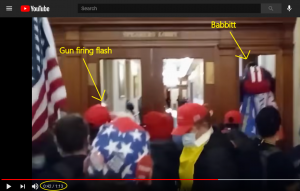
Photo #16 also shows the exact moment Babbitt is shot. The gun flash can just be seen as noted in the photo. In explaining why he decided to shoot her, recall that the lieutenant said he was worried about what might be contained in her backpack. But notice the angles here and likely concealment of the backpack from the lieutenant’s view by the heavy door frame. It just doesn’t appear credible that the backpack could have been a factor in his decision to fire.
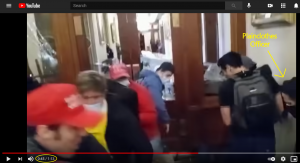
Just 3 seconds after Ashli Babbitt is shot and drops backward onto the floor, the plainclothes officer/supervisor moves quickly to attend to Babbitt as seem in photo #17. Notice the shooter has retreated back into the side doorway.
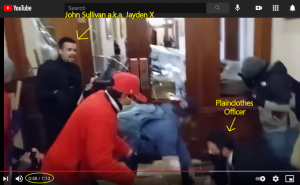
This screenshot (photo #18) shows the vantage point of John Sullivan a.k.a. Jayden X. It also shows the plainclothes officer/supervisor attending to Babbitt but still no sign of the shooter who remains hiding in the side doorway now 6 seconds after the shot was fired.
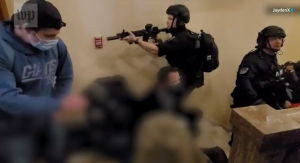
Here in photo #19, still just seconds after the shooting, and as the plainclothes officer/supervisor is seen in the center of the blurred out screenshot as taken by Sullivan, a tactical team member aims his gun in the direction of the shooter before seeing the lieutenant off to the side in the Speaker’s Lobby.
With at least 9 Capitol officers within a few feet of Ashli Babbitt, she was the victim of lethal force with no video evidence of physical restraint by the officers present nor any audible verbal warning from the lieutenant who fired the shot.
* * *
It is not debatable that the behavior of the rioters at the Capitol was appalling and criminal. The damage they did not only to the building itself but to their purported cause through violence and mob action will provide ammunition to their political opponents for perhaps years to come.
It’s also a valid exercise to consider the mindset of Lt. Byrd leading up to the shooting. Just from these videos and photos, it was clear there was a considerable difference in the degree of concern between those inside the House Chamber / Speaker’s Lobby area and those officers outside the fateful doorway. Though they were literally face-to-face with what was clearly a violent mob (they were destroying the windows in the doors), these USCP officers didn’t appear to have same concern for their physical safety. The crowd almost ignored them.
Consider that Lt. Byrd had just come from the House Chamber where doors were strongly barricaded, guns drawn and House members terrified. Likely just a few short minutes prior to the lieutenant’s arrival at the side doorway where he decided to make his stand, representatives had exited out that very hallway albeit at the far end.
So it’s quite likely his apprehension was at a much higher level when he arrived at the southeast entrance to the Speaker’s Lobby. He saw a loud, violent crowd doing what they could to breach the door. Knowing he was by himself (still undetermined), he may have thought he was the last line of defense in stopping the mob from making a beeline to the exiting House members.
Is this a possibility? Absolutely.
But given that members were not visible in the Speaker’s Lobby, it is not unreasonable to conclude that the representatives had already safely exited that area of the Capitol and were no longer in any danger.
He must also have been quite fearful as just stepping out a few feet into the hallway, especially with his gun drawn, would have given him an unobstructed view of his fellow officers and the tactical team at the scene. It is also unlikely Babbitt would have decided to breach the opening had she seen him holding a gun.
The bizarre way the Capitol police dealt with the situation ought to be explored as well. It is uncertain how orders were communicated to the USCP and where officers were directed. This is particularly curious at the location where Babbitt was shot.
Capitol Police are under “The Use-of-Force Continuum” that outlines the specific protocol that officers are required to follow when they deem force is necessary to control a situation.
In general, the policy ramps up the degree force needed from: just an officer’s presence — to verbal commands — to empty hand control — to non-lethal options (baton, chemical spray, Tasers, etc.) — to the highest level or lethal force that requires use of a firearm.
This final, deadly option must only be used if the subject is deemed a very serious threat to the officer or others. Additionally, the officer’s surroundings are vitally important as he or she should never shoot into a crowd.
Although the lieutenant clearly violated the “Continuum” protocol, not only will there by no criminal charges filed but there are no reports of even disciplinary action taken against him.
Babbitt was clearly trespassing, but she was also completely unarmed. There has been no claim that she threatened anyone including any police officer with bodily harm. The Babbitt’s family lawyer, Terry Roberts, says Babbitt’s homicide was “an egregious act of excessive force.” “Witnesses confirm that the officer did not give Ashli a single verbal warning prior to firing.”
The lieutenant’s lawyer, Mark Schamel, said his client only fired after Babbitt crawled through a doorway where the glass had been broken, after police had ordered her and other rioters not to breach the locked doors and enter the hallway. (My emphasis)
This statement is inconsistent with the video evidence. If the shooter didn’t know there were other officers in the doorway area and was not in communication with them, how could he possibly know that the crowd had been instructed not to enter the area? Mr. Schamel’s statement is not believable.
The Justice Department’s statement announcing the DOJ would not “pursue criminal charges” does not say the shooting was justified. It only says that prosecutors believed they could not prove that the officer’s actions were both “constitutionally unreasonable” and that he acted “willfully.”
The statement said that a “high level of intent” could not be established if the officer acted out of “fear, mistake, panic, misperception, negligence, or even poor judgment.”
So using lethal force on an unarmed woman due to “panic …or poor judgement” allows a police officer to shoot without repercussions? Really? Just these two excuses ought to then exonerate any police officer for any future shootings anywhere.
According to George Washington University Professor Jonathan Turley, if the lieutenant intended to shoot Babbitt (the video evidence clearly shows he did), it did not “likely meet the standard for a justified shooting under governing cases like Tennessee v. Garner (1985).” And If the officer shot blindly or haphazardly, it would clearly be negligence.
According to Professor Turley, the DOJ doesn’t even explain whether the officer was firing directly at Babbitt or at the general mob. That is stunning based on the visual evidence in just these two videos (the DOJ has committed to spend between $6 million and $26 million according to Politico for a database of thousands of hours of video evidence from January 6th).
Turley says “live rounds have never been authorized absent a particular showing of a significant threat to an officer or others. Nothing in the announcement in the Babbitt case answers how such a showing was made by the officer.”
* * *
Ashli Babbitt was both very foolish and extremely unlucky on January 6th.
- Had she stayed home that day she’d be alive today.
- Had she not decided to crawl through the sidelight she’d be alive today.
- Had Lt. Byrd not been alone on his side of the doorway, two officers might have more visibly shown themselves with weapons drawn to restrain the mob rather than firing at the first person through.
- Had the shooter told Babbitt to stop or issued any verbal instructions, she might be alive today.
- Had the four USCP officers not appeared to cede their ground and remained at the doorway until they were clearly reinforced by the tactical team Babbitt would be alive today.
- Had the mob even been quieter the plainclothes officer/supervisor might have been able to communicate to the tactical team leader more quickly than the 28 seconds the team was apparently delayed in taking its position in front of the doorway, Babbitt might be alive today.
- Had the USCP officers just communicated with each other within the approximately 20′ where they were standing from each other Ashli Babbitt would be alive today.
- And had Lt. Michael L. Byrd shown a little more courage and considerably more restraint in his use of lethal force, Ashli Babbitt would be alive today.
Shockingly, Professor Turley says that within an hour of the release of the DOJ’s statement that it would not prosecute the shooter of Babbitt, Minnesota prosecutors announced the indictment of police officer Kim Potter in the deadly and apparently mistaken shooting of Daunte Wright when she thought she was firing her Taser but instead fatally shot Wright with her service weapon.
It’s very difficult to believe that race and politics were not strong considerations in the decisions of both prosecutors.
In Minnesota, the police officer was white and the victim black. In D.C., the shooter was black and the victim white. In Babbitt’s case, according to all who control Washington and the media, she was a loathsome “insurrectionist” who deserved what she got. In Wright’s case, he was an unarmed innocent who was targeted for a traffic stop simply because he was black.
So the officer who mistakenly used her gun when she thought she was firing her Taser is quickly criminally charged but prosecutors determined that another police officer who actually leaned forward into the shooting of an unarmed woman did not do so “willfully” or with intent — and goes away scot free.
It’s difficult to believe justice has been served in the tragic, execution-like death of Ashli Babbitt.


Ashli Babbit was shot while participating in a violent insurrection. She joined a mob of seditious traitors and attempted to stop the peaceful transfer of power. They tried to overthrow our government. I’m surprised more people didn’t die. The Capitol Police showed remarkable restraint.